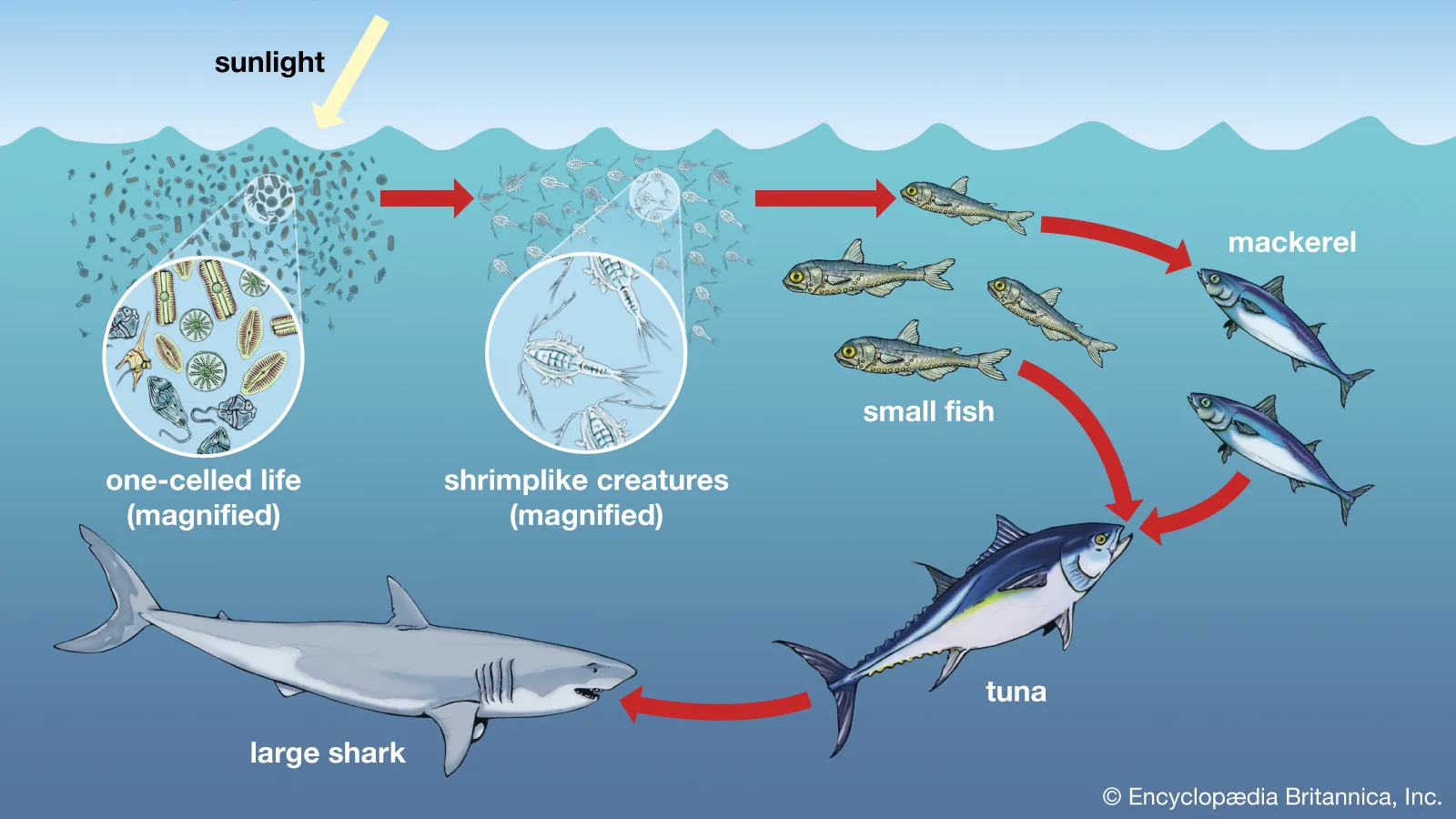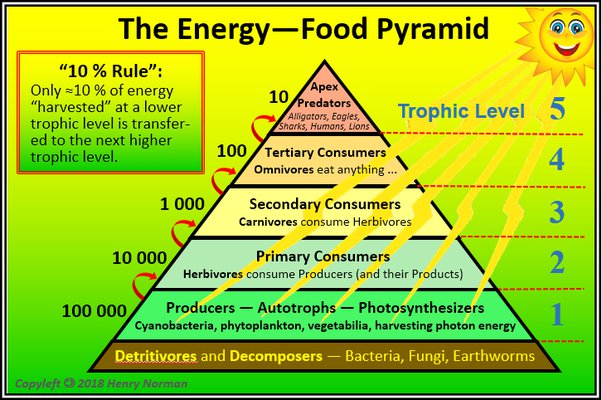Food Chain
 Graphics courtesy of BritannicaOpens in new window
Graphics courtesy of BritannicaOpens in new window
|
- A Food Chain, therefore, is the sequence of living organisms in an ecosystem in which one organism eats other organism and in turn is being eaten.
- The various components or levels of food chain can be defined as a group of organisms in which there is a transfer of food energy through a series of repeated eating and being eaten.
Charles Darwin is said to have told a story about a village that produced higher yields of hay than the nearby villages because it had more old ladies. Darwin reasoned that the old ladies kept more cats than other people and these cats caught more field mice.
Field mice are important predators of wild bees and since these bees were essential for pollination of red clover (and clover improved the yield of hay), the increased number of bees increased the hay yield.
This is an example of a ‘food chain’ which highlights the fact that plants and animals in the ecosystem have important feeding relationships which affect the overall success of the system.
Plants, being the producers, always form the first link in the food chain. Thus a food chain begins with producers, is continued by consumers, i.e. animals of varying orders, and is completed by decomposers (or reducers), namely bacteria and fungi.
But the reducers are often omitted since they operate at all levels of a food chain. Thus a food chain always begins with plants and ends with a larger animal which is not preyed upon by anyone.
The Biomass and Energy Flow
The weight or volume of living plant and animal material in an ecosystem is called its biomass. The flow of biomass in a food chain as organisms feed on each other can be represented as a pyramid.
At the base is the primary producer (i.e, a rose plant), resting on this is the primary consumer (aphids), and above this is the secondary consumer (birds). Each level in the pyramid is termed a trophic level.
 Figure X-1. The Energy Food Pyramid. Credit: Internet
Figure X-1. The Energy Food Pyramid. Credit: Internet
|
The pyramid shape reflects the loss of matter from the food chain in that whenever biological material is consumed at each level some matter is lost as waste, or through release of gases and water in respiration.
Using a rose as an example, this means that the total biomass of rose material must always be more than the biomass of aphids which feed on it which, in turn, is always more than the biomass of the birds which feed on the aphids.
In this ways, if we reduce the rose biomass available in the garden (say by reducing the size of the rose bush or planting fewer rose bushes), this will have an even greater impact on the number of birds because their biomass is comparatively smaller.
The primary source of energy is sun. Green plants alone are able to trap solar energy, which they use to reduce carbon from carbon dioxide. This carbon forms carbohydrates, fats and proteins — the fuels of life. Energy trapped in these compounds is stored in the plants and forms the primary source of energy supply to all other living organisms.
In practice, much of the biomass lost as waste and dead organic matter is recycled by a whole group of organisms called decomposers and detrivores which feed on dead organic matter. As well as the flow of biomass, there is also a loss of energy through the system.
The process of photosynthesisOpens in new window enables the plant to convert sunlight energy into chemical energy, which is stored in the biomass of the plant. As the plant is eaten by primary consumers, approximately 90% of the energy trapped in the leaf is lost either by respiration, or by heat in the consumer’s body, by waste which is excreted by the consumer and by death organisms.
Since matter and energy are lost from the food chain at each trophic level, this explains why only a limited number of levels are possible. Eventually a point is reached where there is insufficient biomass and energy to sustain a further level of organisms (which is why large carnivores are comparatively rare).
Gardens are highly productive and can produce a large amount of plant biomass, and the greater the biomass, the more consumers it will support. A densely planted border, for example, is estimated to produce 0.5 – 2.0 kg of biomass per square metre per year.
Therefore in a garden the aim is to provide as rich a variety of organisms as possible, that is, a high biodiversity at every level together with as much plant biomass as can be achieved to maintain a healthy and functioning ecosystem.
| Table X-1 VARIOUS TYPES OF FOOD CHAINS |
|---|
There are three types of food chains:
|
The Food Chain Examples
The food relations, as a matter fact, can be very complex even in a small community. It can be illustrated by a food chain in a pond and also by a food chain on land.
- Food Chain in Aquatic Ecosystem
A fish pond is an aquatic ecosystem that provides best example of predator food chain. In a pond, phytoplankton are the producers. The zooplankton such as copepods are the primary consumers which feed on phytoplankton.
The zooplankton in turn are fed upon by certain invertebrates such as aquatic insects and are the primary carnivores or secondary consumers in the food chain.
The aquatic insects and other smaller animals are consumed by fishes. The small-sized fishes are eaten up by the large-sized fishes and represent further trophic levels in the food chain such as secondary and tertiary carnivores. Thus the sequence of food cahin in an aquatic ecosystem may be represented as shown in Table X-2.
| Table X-2 FOOD CHAINS IN DIFFERENT ECOSYSTEMS | |||||
|---|---|---|---|---|---|
| Types of Ecosystem | Producers | Herbivores | Primary Carnivores | Secondary Carnivores | Tertiary Carnivores |
| Grassland ecosystem |
|
|
|
|
|
| Pond ecosystem | Phytoplankton |
|
|
|
|
| Forest Ecosystem | Trees |
|
|
| |
- Food Chain in a Terrestrial Ecosystem
There are innumerable examples of food chains in the terrestrial ecosystem and all of them represent the same trophic levels as found in the food chain of aquatic organisms. The basic trophic level is occupied by autotrophic plants, i.e., the producers.
The producers of terrestrial ecosystem are chiefly dominated by large-rooted green plants called the trees, shrubs, herbs and grasses. Correlated with the large number of niches provided by producers, the consumers exhibit extreme variations.
The primary consumers include not only small organisms like insects but also very large herbivores, such as hoffed mammals. Frog is herbivorous in larval stage and carnivorous in the adult stage. Many mammals such as fox, bear and man are omnivorous. The sequence of various food chains in the terrestrial ecosystem may be represented as in Table X-2.
Ecological Principles in the Food Chain
Following important ecological principles emerge from the study of food chains:
- There is unidirectional flow of energy from sun to producers and then to a series of consumers in a food chain. Thus a food chain always begins with photosynthesis and ends with decay.
- The shorter a food chain, the more efficient it is. The more steps it has, the greater is the wastea of energy.
- The size of any population is determined by the number of trophic levels in a food chain. With the decrease in useful energy at each step, there is a decrease in the population size. Thus the size of a population of quaternary consumers is less than that of tertiary consumers and that of tertiary consumers is smaller than secondary consumers.
You might also study:

